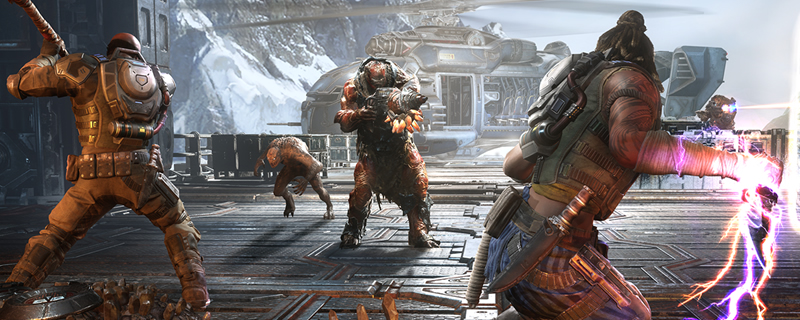Gears 5 PC Performance Review & Optimisation Guide
Conclusion
When talking about Gears 5, we must first credit Microsoft for the effort that they, and The Coalition, have put into both Gears 5 and the PC platform as a whole. Moving Gear 5 to Win32 (rather than UWP) is an excellent move for Microsoft. Furthermore, Microsoft’s move away from the Microsoft Store with their new Xbox App, and Steam availability showcases the consumer-first focus’ of today’s Xbox team.Â
Even Gears 5’s little features like the addition of an optional high-resolution textures pack work to showcase Microsoft’s progress. With Gears of War 4, a common complaint about the game was regarding its install size. With Gears 5, high-resolution textures are now optional, allowing PC users to save 30GB of storage space if they desire. This is great news for those who have little storage space on their PC or lack enough VRAM to utilise Gears 5’s highest-quality textures.Â
VRAM-wise, Gears 5’s Ultra settings will use around 4GB of VRAM at 1080p and 6GB at 4K when using the game’s basic texture pack. This increases to around 8GB with the game’s high-resolution texture pack enabled. Users of 4GB graphics cards should have no issues running Gears 5, assuming they also have enough GPU grunt.Â
When it comes to the AMD VS Nvidia debate, Gears 5 offers no clear answers. Our ROG Strix GTX 1060 handily beats AMD’s Radeon RX 580 while AMD’s Radeon RX Vega 56 is on par with Nvidia’s RTX 2060. Moving on to Navi and we can see AMD take a huge lead over its Nvidia rivals. Powercolor’s RX 5700 XT Red Devil gave Nvidia’s RTX 2070 Super a run for its money. AMD’s Radeon RX 5700 (non-XT) Red Devil also bests Nvidia’s standard RTX 2060 with ease.Â
Another interesting thing to note is that the Radeon RX 5700 XT also offers performance levels which are on par with AMD’s Radeon VII. This level of performance showcases how much Navi’s architectural improvements have impacted its game performance. This leaves us very excited to see future, high-end, RDNA graphics cards.Â
In terms of CPU performance, Geas 5 is a game that benefits from multi-core processors. Using six cores delivered us more performance than using four, though a strong quad-core is more than enough to deliver a steady 60FPS experience in Gears 5. Higher framerate targets will necessitate more powerful processors.Â
Settings-wise, Gears 5 shows the industry how it’s done. This game offers around 40 distinct graphics options, and many of them provide previews that can showcase how these settings impact Gears 5’s visuals. In addition to this, each option details its impact on GPU performance, CPU performance and VRAM utilisation. When it comes to system memory, Gears 5 used around 8.5GB of RAM at Ultra settings.  Â
One of Gears 5’s most noteworthy features is the game’s support for variable resolution rendering. This feature allows the Gear 5’s internal resolution to adjust itself to achieve the player’s desired framerate. This lets PC gamers to try to mitigate performance dips by enabling the game to adapt the game’s resolution dynamically. For example, if your GPU isn’t up for 4K gameplay, the game can adjust itself on the fly to help maintain high framerates. In effect, the game will run at the highest resolution it can while meeting your desired framerate target. Â
In the video below, we used this feature when playing Gears 5 at 4K using a Powercolor Radeon RX 5700 XT Red Devil. This enabled us to play the game at a mostly stable 60FPS. This feature is handy for mitigating performance dips. If you prefer to minimise performance dips, this will be a setting that’s worth enabling. I’d prefer to a temporary dip in resolution over a sudden or sustained framerate drop.Â
When it comes to settings adjustments, we will note that many of Gear 5’s options have a minimal impact on performance. These adjustments add up with the game’s Low, Medium, High and Ultra settings presets, but many have a minor impact on an individual basis. Some settings are also very situational, having no effect on some scenarios while having a major impact on others. We will note there that Shadow Quality, Ambient Occlusion, Depth of Field, Volumetric Fog and Screen Space Reflections are some of the heaviest settings that can be adjusted in Gears 5. Â
Page 5 details how each of Gears 5’s graphical presets can impact performance, while page 3 highlights how these presets change the game’s visuals. We will note here that High and Ultra feature some significant differences in graphical quality, though we will note that Gears 5 can still look great at Medium or High. We expect most PC players to target high settings and adjust the game’s visuals from there. Â
Gears 5 is a game that can look incredible on PC, but with that can come some high-performance costs. Thankfully Gears 5 offers more than enough scalability options to enable anyone with relatively recent hardware to enjoy the game at 60FPS. Anyone with an RX 580/GTX 1060 or newer will be able to enjoy 1080p 60FPS gameplay at High settings, and users of higher-end cards can enjoy using higher settings and benefit from higher game resolutions.Â
The release of Gears 5 marks the dawning of a new era for Microsoft’s PC gaming efforts. Gears 5 runs well, is available on multiple storefronts, is available cheaply via Xbox Game Pass and offers gamers an extremely enjoyable campaign. When two months Xbox Game Pass Ultimate cane be purchased for £2 (at the time of writing), there is no excuse for PC gamers not to give Gears 5 a try.Â
(At the time of writing most new Radeon graphics cards ship with three months of Xbox Game Pass for PC, granting players access to Gears 5’s PC version as well as hundreds of other titles.)Â
You can join the discussion on Gears 5’s PC performance on the OC3D Forums.Â



